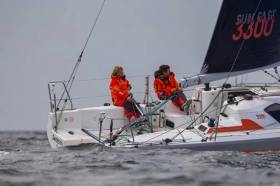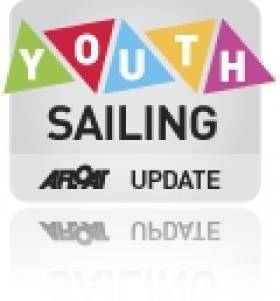Displaying items by tag: Keelboats
Howth Yacht Club Hosting Keelboat Spring Warmers on 27 April
Attention all keelboat sailors: Howth Yacht Club is running a one-day spring warmers event on Saturday 27 April for Cruiser Classes 1, 2, 3 and J80s.
The club says this is a perfect opportunity to dust down the cobwebs and get ready for the season. In other words: race, train and have fun!
First gun will be at 10:55 am with four sprint style races and 50 tacks and gybes to get crews mobilised after the winter break.
The day will also feature on-the-water coaching and a video debrief from sailmaker Barry Hayes and offshore sailor Kenny Rumball.
Sign up for the HYC Spring Warmers HERE.
If you are interested in chartering one of the club J80s for the day, contact the HYC sailing office.
Bray Sailing Club Keelboat Regatta Set for Next Weekend
Bray Sailing Club has announced details of its Keelboat Regatta to be held next Saturday 20 May.
Racing will be provided for cruisers, both fin- and bilge-keel boats and Flying Fifteens — and visiting competitors are also very welcome.
The Sailing Instructions and Notice of Race can be downloaded HERE.
Non-members can register by completing the online registration form HERE.
The event will be followed by prize-giving and a barbecue, the club adds.
Groundbreaking Diploma in Sporting Excellence Returns for English Youth Sailors in 2022
School students in England starting Year 12 this September who are interested in racing keelboats and want to have a future career in sailing or sports science have the change to apply for the RYA’s Diploma in Sporting Excellence programme for 2022.
The Diploma in Sporting Excellence (DiSE) is a two-year education programme and a unique sporting qualification designed to meet the needs of student-athletes who exhibit the potential to achieve excellence in their sport.
DiSE supports young sailors in the talent system in England to combine sport and education so that they have the skills, knowledge, and competence to pursue sporting excellence alongside developing the skills and qualifications for a post-sailing career.
And it may provide a model for the advancement of youth sailors in other RYA regions, such as Scotland and Northern Ireland.
The programme provides a comprehensive syllabus to support young sailors to gain an additional qualification (worth 64 UCAS points) and achieve their full potential within the RYA sailing/keelboat pathway. The programme aims to increase the accessibility and diversity of the sailing participation base and talent pathway.
Each year the RYA bids for programme places through Sport England and Department for Education. This year we were successful in securing 12 places in an ever-continuing competitive process with all Olympic and non-Olympic sports.
“We are tremendously proud of the impact and difference this programme has made within the youth classes and keelboat sailors,” said Jack Grundy, RYA performance manager and DiSE programme lead.
“This programme has helped sailors’ next steps within the maritime, performance pathway and higher education options. More importantly, it has given them further development in all the small things like nutrition and psychology that help them mature into professional sailors for the future.”
 The programme aims to increase the accessibility and diversity of the sailing participation base and talent pathway | Credit: Paul Wyeth/RYA
The programme aims to increase the accessibility and diversity of the sailing participation base and talent pathway | Credit: Paul Wyeth/RYA
Ellie Thomas, a 420 sailor on DiSE, added: “The DiSE programme has been hugely beneficial to my sailing. The training camps have been amazing with some great quality coaching. The theory sessions have helped me to understand what else goes into being successful within sport. The programme has run smoothly due to the great organisation, and it has been great to be a part of it.”
To be eligible for the DiSE programme, a student must meet the following criteria:
- Be aged 16 to 18 and starting Year 12 in September 2022, in full-time education (or aged 19 to 24 if they have an Education, Health and Care (EHC) plan), when they start the programme.
- Aspire to progress onto the British Keelboat Academy or other future performance programmes.
- Be studying at a state education institute, or if a student attends a fee-paying school, they must be in receipt of one of a 50% scholarship. See the application form for further details.
- Ideally have a minimum of five GCSEs at a minimum grade of 4 (or above), including Maths and English.
The programme only only 12 places, and these are being run exclusively on a keelboat programme in line with Sport England’s aims and impact of DiSE. Therefore, the technical and tactical sessions will be on a keelboat with other students who you may not have met before.
The technical and tactical element (sailing) will usually take place over eight weekends, with delivery over 18 months. The theory will take place at camps and remotely. Access to laptops will be required.
The programme will commence in late October or early November and is more than just sailing; successful applicants will be required to complete coursebooks and will have access to 1:1 sessions with a sports psychologist, sports nutritionist, mentor and coach sessions which are a part of the Diploma. You will also be required to record all sailing and training hours outside of the programme.
Click HERE for the application form, which requires parental/guardian consent.
Applications must be submitted by 11.59pm on Sunday 4 September. If you have any issues with submitting the form, email [email protected]. You will be notified by Friday 9 September if your application has been successful.
Keelboating Opportunity for Youth Sailors in Scotland
RYA Scotland are looking to identify a team of young sailors from Scotland to go to the British Keelboat League Championship Finals in Southampton in September 2022.
An online information session on Tuesday 24 May at 7pm will set out the opportunity that will see the selected team having all their expenses to attend the finals met by the event sponsors, A-plan insurance.
“Our intention is to encourage clubs with existing keelboat activity to engage and develop their own team of young keelboat sailors who will go forward from the club to attend a Scottish training and finals weekend – to be run at Port Edgar Yacht Club on 3 / 4 September 2022,” RYA Scotland says, explaining that the concept is similar to the Scottish Club Trophy.
The purpose is to support clubs in developing new interest in keelboat sailing in their younger club members, develop teamwork principles in young sailors and provide an entirely different boating experience for the target age range for whom dinghy sailing is the predominant expectation.
Clubs can organise their training arrangement any way that works at the club to train or select a team. The choice of keelboat does not mater but we suggest it should be below 25ft and run with a maximum crew of five. The Scottish training and finals weekend will be in the 707 one design class.
Basic pre-requisites:
- Teams being entered for the Scottish final should consist of 4 or 5 sailors aged from 16 - 25 (inclusive) with a maximum of three male sailors
- The team should be able to sail a triangular course and handle a standard spinnaker as a minimum capability
- Team members should be members of the RYA, either as an individual or under a family membership
- The winning team must be available to attend the British Keelboat League Championship Finals at Royal Southern YC in Southampton, 30 September to 1 October 2022
Interested clubs in Scotland can reserve their place in the information session by emailing [email protected] or alternately call James Allan (CEO at RYA Scotland) on 07824 887247 or Kevin Aitken (RYA Scotland Board Member) on 07778 788855 to discuss the opportunity.
Howth Yacht Club Launches Crew Sailing Saturday Sessions
Next month, Howth Yacht Club will host the Crew Sailing Saturday Sessions, a three-session refresher course designed to get you back in sailing condition before the summer season kicks off.
Whether you’re in search of a crew or just want to shake off the cobwebs after a long winter, our keen keelboat instructors will get you in ship-shape before the official start of the season.
The sessions mean time on the water with club J-80 keelboats, and a chance to sharpen your skills with a fully qualified instructor.
Courses are designed in-house by Saoirse White, a Howth Yacht Club member who regularly races on Howth 17s, Puppeteers and cruisers.
There will also be a meet-and-greet with class captains in a reserved area of The Lighthouse, HYC’s new pergola, after each session to connect with savvy sailors or find a like-minded crew.
Each session runs from 9.30am to 1.30pm starting Saturday 2 April, with the second and third sessions on 9 and 23 April respectively. The cost is only €125 per member for all three sessions.
For more information and to book your spot, visit the Quest Howth website HERE.
O’Leary Insurances Winter League at Royal Cork Will Be All-In White Sail Racing for 2021
The Royal Cork Yacht Club has announced that this year’s O’Leary Insurances Winter League will be run as an all-in White Sail league.
The club says it initiated the trial event for 2021 to encourage as many keelboats as possible out for the Cork Harbour league, where all boats will be racing against each other for the Archie O’Leary Trophy.
Clem & Wendy McElligott will be back in the OOD boat for the league which kicks off this Sunday 7 November. First Gun will be 12.25pm with one all-in race per day.
The Notice of Race, with links to the entry form and race declaration, is available from the RCYC website HERE.
‘Unexpected Opportunities For New Sailing Nations’ In Olympic Offshore Keelboat Class
“The tide is turning” on the prospect of offshore sailing at the Olympics, says Seahorse Magazine as it proposes how the new keelboat category could make the sport more accessible than ever.
Last year’s introduction of the Mixed Two Person Offshore Keelboat for Paris 2024 provoked much discussion as to how it might transform the landscape for Olympic sailing — with a number of Irish sailors who has previously never envisaged an Olympic campaign showing interest.
Now that more details have begun to emerge on the new event, Seahorse’s Matt Sheahan writes: “It is becoming clearer that there are important new opportunities with significant benefits to both the sport and the Olympic Games.
“Indeed, some now believe this new discipline could provide unexpected opportunities for new sailing nations, while paradoxically also having the potential to be more affordable than some existing Olympic classes.
“The move is also being seen as having potential to open Olympic sailing up to a broader range of competitors.”
Sheahan points out that the idea has been floated to hold qualifications in chartered boats already available on a regional basis.
World Sailing’s decision on equipment meeting the class’ key criteria may not be made until 31 December next year, or even as late as the end of 2023 — in which case “qualifying nations should have finalised their qualifications before the Olympic equipment is chosen,” says World Sailing president Kim Andersen.
“That way you’re keeping a level playing field for competitors who will focus their efforts on actually getting a medal at the Olympics rather than gaining an advantage through having spent a lot of money and time procuring boats for which there is no demand back home.”
Seahorse Magazine has much more on the story HERE.
Open Selection Evening for 2013 HYC U25 Keelboat Team
#HYC - The K25 team at Howth Yacht Club is planning for 2013, including the considerable challenge of competing in the BMW J/24 World Championships next August.
If you are interested in applying for the youth keelboat team, please attend the open evening on Tuesday 27 November at 8pm in Howth Yacht Club.
Candidates need to be under 25 on 30 August 2013 and become a cadet member of HYC for the 2013 season. Applications received on the night will be given a free drink from the bar.
See the HYC website for more details.
Young Bigboaters Sought for UK Academy
Applications are open for the RYA's British Keelboat Academy, which aims to give keelboats sailors aged between 18 and 24 a leg-up into competitive international sailing.
The programme utilises a fleet of J80s, identical to the ISA's sailfleet J80s, and also involves sailors in campaigning the TP52 John Merricks II, which is slated to compete in the Sevenstar Round Britain & Ireland later this year.
There is no similar scheme here in Ireland, but judging by recent entries to the likes of the Round Ireland, and the makeup of squads in keelboat events around Ireland, youth interest in keelboat sailing is high.
The Pride of Wicklow entry in the Round Ireland race, crewed by under-21s, surpassed all expectations by finishing fifth on the water and third in class, and the likes of the young crew on board Tiger have consistently shown a clean pair of heels to older and more experienced boats.
Interested parties must fill out the forms HERE and must be a member of the RYA. This scheme might suit young sailor studying in the UK, or those willing to travel for training on a regular basis.































































